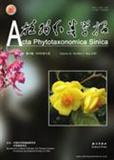DAI Shao-Jun, WANG Quan-Xi, BAO Wen-Mei, ZHANG Xian-Chun, ZHANG Da-Wei
2005, 43 (3): 233–245
The spore morphology of 50 species of 14 genera of Thelypteridaceae from China was investigated under scanning electron microscope (SEM). The spores are monolete and bilaterally symmetric, elliptic, broadly elliptic or subrounded in polar view and kidney-shaped or rounded in equatorial view. The polar axes are 16.8-40.5 um long, and the equatorial axes are 12.8-58.0 um. On the basis of their ornamentation pattern, the spores are divided into seven types. (1) Psilate. Spores of Phegopteris decursive-pinnata belong to this type. (2) Retate. Spores of Pseudophegopteris belong to this type. (3) Circinate. Spores of Glaphyropteridopsis, Macrothelypteris oligophlebia belong to this type. (4) Fimbriate-alate. Spores of Parathelypteris subimmersa, P. japonica, P. angulariloba, Cyclogramma auriculata, most species of Macrothelypteris, and some species of Cyclosorus belong to this type. (5) Perforate-lophate. Spores of Parathelypteris, Mesopteris, Metathelypteris and P. connectilis belong to this type. (6) Cristate. Spores of Cyclosorus belong to this type. (7) Echinate. Spores of Leptogramma, Dictyocline, Thelypteris, Pseudocyclosorus subochthodes, most species of Cyclogramma, and some species of Cyclosorus belong to this type. The relationships of some genera in the Thelypteridaceae are discussed based on spore morphology.










